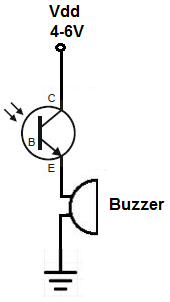How to Build a Simple Phototransistor Circuit

In this project, we will go over how to build a simple phototransistor circuit, that can act as a light detector, a device that can detect the presence of light.
A phototransistor is transistor which is switched on by the presence of light.
A phototransistor, just like a regular transistor, has 3 terminals, a base, a collector, and an emitter. However, when you look at a phototransistor, you will only see 2 leads, the collector and emitter. The third lead is not physically a lead, because the base isn't a normal metallic lead, like the other 2. Instead, the base is made up of light sensitive material that detects whether light is present on the phototransistor or is not.
The presence of light allows for phototransistor conductivity, while the absence of light does not.
With enough light to the base of the transistor, the transistor collector-emitter junction breaks down and the transistor is able to conduct current across from collector to emitter.
In the absence of light to the transistor's base, the barrier stays in place and the transistor cannot conduct current from collector to emitter.
Thus, when enough light is shining on the phototransistor, it can conduct electricity to any device attached to its emitter lead. Thus, in this way, the circuit truly can act as a light detector.
In this project, we will build the most basic phototransistor that is really possible.
We will make it so that when light is shined
on the phototransistor, such as from a flashlight, a buzzer will go off. So this circuit can act as a kind of light alarm circuit-
if light is shone
on the circuit, a buzzer will go off.
Parts Needed
- Phototransistor
- 4.5-5V of power
- Buzzer
Phototransistors are very cheap and can be bought from a number of online retailers. One place where it can be bought for cheap is at the following online retailer: Tayda Electronics- Phototransistor.
The amount of power that you need for your circuit depends on the load you are powering, which in our case is the electronic buzzer. The amount of voltage which the buzzer needs depends on the type you are using. Some buzzers need as little as 3V, while others may need 12. So the amount of voltage which you need powering this circuit depends on the power needs of the buzzer. If in doubt, check the datasheet for the buzzer. If you can't, just power the buzzer until it turns on loudly; this way, you will know how much voltage it needs to power on.
If you don't have a buzzer, you can always power any other type of load, such as an LED or a fan, etc. Just know the amount of
voltage the device needs, so you can adjust the circuit to the voltage necessary.
Phototranistor Circuit Schematic
The phototransistor circuit we will build is shown below.

This is pretty much the most basic phototransistor circuit that we can build.
When light as from a flashlight is shone on the phototransistor, it breaks the threshold barrier and allows current to flow from the collector to the emitter, allowing the buzzer to sound.
In the absence of light, the barrier remains and current cannot flow from collector to emitter.
To see this circuit in action, to see how it works in real life, see the video below.
Related Resources
How to Drive a 7 Segment LED Display with an Arduno
How to Build a Dark-activated Light Circuit
How to Build a Hall Effect Sensor Circuit
How to Build a Touch Sensor Circuit
How to Build an Accelerometer Circuit
How to Build a Motion Detector Circuit
How to Build a Motion Detector Alarm Circuit